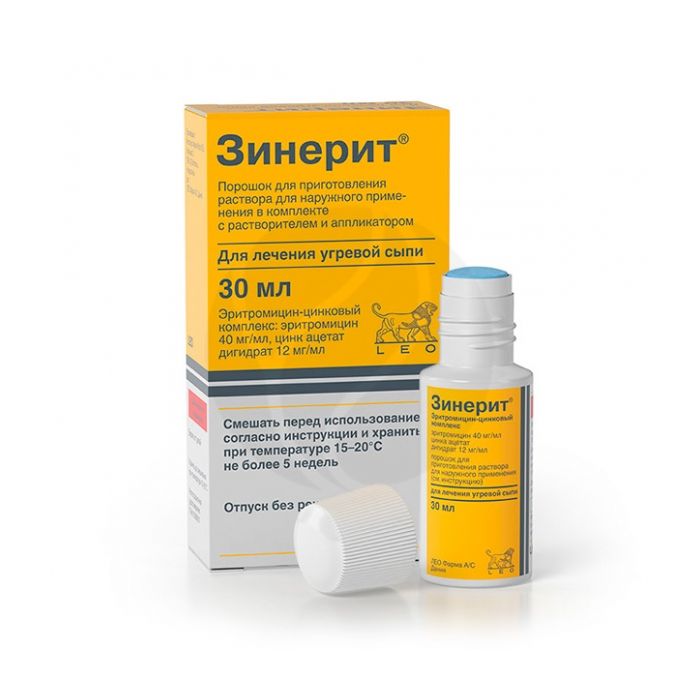Zinerit powder for preparation of solution for external use, 30 ml
Russian Pharmacy name:
Зинерит порошок для приготовления р-ра для наружного применения , 30 мл
Acne treatment.
Outwardly. Using the supplied applicator, Zinerit is applied in a thin layer to the affected area of ??the skin 2 times a day: in the morning (before applying makeup) and in the evening (after washing). The drug should be applied by tilting the bottle with the prepared solution down, with light pressure. The rate of application of the solution is regulated by the force of pressing the applicator on the skin. An approximate single dose is 0.5 ml. After drying, the solution becomes invisible.
The duration of the course is 10-12 weeks. In some cases, clinical improvement is possible after 2 weeks.
For 1 vial.
erythromycin - 1.2 g
zinc acetate dihydrate micronized - 360 mg
Solvent (auxiliary components): diisopropyl sebacate - 7.81 g, ethanol - 17.1 g
Plastic bottles (1) complete with solvent (bottle 30 ml 1 pc.) And applicator - cardboard packs.
* auxiliary components in 1 ml of the prepared solution: diisopropyl sebacate - 0.25 g, ethanol - 0.55 g.
The amount of active components, erythromycin and zinc acetate dihydrate, was increased by 3.35% in order to compensate for their concentrations in the preparation of the finished product, the nominal volume of which increases when the active components are mixed with a solvent (every 1000 mg of powder is equivalent to 0.79 ml); the amount of active substances, taking into account 3.35%: erythromycin - 1.24 g, micronized zinc acetate dihydrate - 372 mg.
An additional increase in the amount of active ingredients, erythromycin and zinc acetate dihydrate, by 5% is associated with the preservation of the declared concentrations of the finished product during storage; the amount of active substances, taking into account 5%: erythromycin - 1.302 g, micronized zinc acetate dihydrate - 389.4 mg.
Hypersensitivity to erythromycin and other macrolides;
hypersensitivity to zinc or other components of the drug.
Clinical and pharmacological group: A drug with antibacterial and comedolytic action for the treatment of acne
Pharmaco-therapeutic group: Acne rash treatment
pharmachologic effect
Erythromycin-zinc complex. It has anti-inflammatory, antimicrobial and comedolytic effects.
Erythromycin acts bacteriostatically against microorganisms that cause acne: Propionibacterium acnes and Streptococcus epidermidis. Zinc reduces the secretion of the sebaceous glands, has an astringent effect.
Pharmacokinetics
The complex bond of active substances ensures their good penetration into the skin.
Zinc mainly binds to the follicular epithelium and is not resorbed into the systemic circulation.
A small part of erythromycin undergoes systemic distribution and is subsequently excreted from the body.
Indications
Acne treatment.
Dosage regimen
Outwardly. Using the supplied applicator, Zinerit is applied in a thin layer to the affected area of ??the skin 2 times a day: in the morning (before applying makeup) and in the evening (after washing). The drug should be applied by tilting the bottle with the prepared solution down, with light pressure. The rate of application of the solution is regulated by the force of pressing the applicator on the skin. An approximate single dose is 0.5 ml. After drying, the solution becomes invisible.
The duration of the course is 10-12 weeks. In some cases, clinical improvement is possible after 2 weeks.
Side effect
Local reactions: sometimes there may be a burning sensation, irritation, dry skin at the site of application of the drug. As a rule, these phenomena are mild and do not require discontinuation of the drug and / or symptomatic therapy.
Contraindications for use
Hypersensitivity to erythromycin and other macrolides;
hypersensitivity to zinc or other components of the drug.
Application during pregnancy and lactation
It has now been established that the use of the drug during pregnancy and lactation is possible according to indications in recommended doses.
special instructions
When using, one should take into account the possibility of cross-resistance to other antibiotics of the macrolide group, lincomycin, clindamycin.
Avoid getting the drug in the eyes or on the mucous membrane of the mouth and nose. it can cause irritation and burns.

